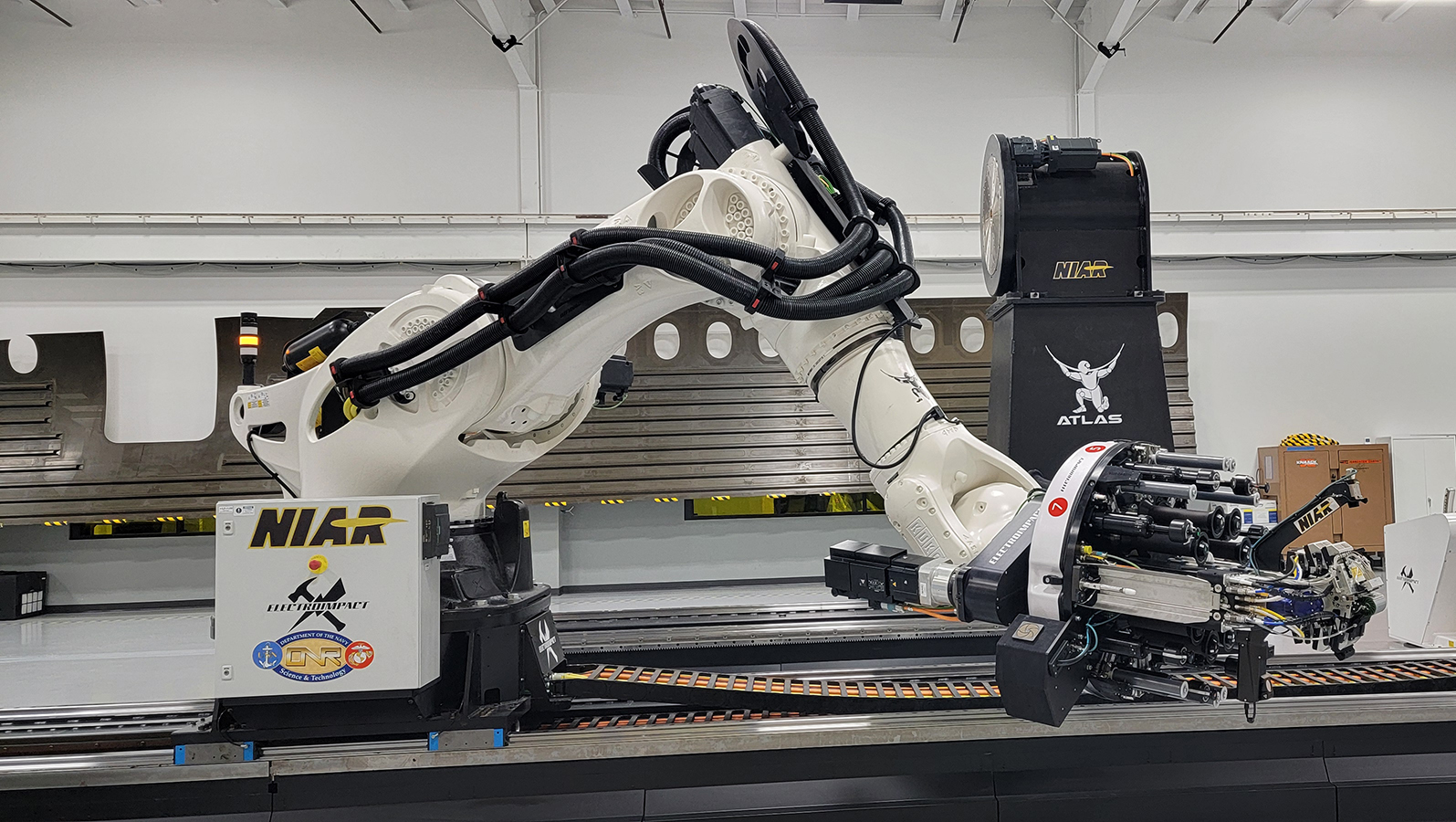Stay Up to Date
Submit your email address to receive the latest industry and Aerospace America news.
Wichita State institute aids companies with rapid prototyping and manufacturing
A white robotic arm towered in front me last month in a cavernous building at the Advanced Technologies Lab for Aerospace Systems, or ATLAS. Hoses along the arm led to nozzles at the end of a large, cylindrical head. The arm was idle at this moment, but if I had been at this spot on a satellite campus of Wichita State University in March, I would’ve seen it rotating and moving back and forth on plastic treads on a track as it laid down carbon fibers.
Staff from eAviation, Textron’s electric aircraft company, were at the facility that month; they built an 11-meter-long carbon fiber section of the wing for the first prototype of the company’s proposed Nexus electric air taxi. The arm and associated equipment were readied for them by staff from ATLAS and students from engineering programs at Wichita State.
ATLAS Director Waruna Seneviratne had imparted the significance of the wing work to me earlier in the day in his office on Wichita State’s main campus. The wing section was made “in a few days,” whereas “it would have taken a few weeks for them to do it manually,” he said.
Now, looking around, I could sense there is room to grow here. The Sector A lab is a former Boeing facility that’s bigger than two football fields and is now equipped with $80 million worth of manufacturing robots and machines.
ATLAS is part of the National Institute for Aviation Research, or NIAR, which is owned by Wichita State. The lab’s main goal is to help electric aviation companies build things quickly.
“A few years ago, you didn’t hear the term ‘advanced air mobility,’ and now when you go to an aviation convention, that’s all you hear about,” Seneviratne told me, referring to the umbrella term for the electric air taxi industry.
“This is like a Disneyland for these companies to come here and do all this prototyping,” he added. “These are small companies, and only a few of them have automated fiber placement machines. But here, they have access to whatever they need.”

ATLAS is also researching high-rate manufacturing techniques that can be deployed once air taxi companies are ready to offer commercial products. Right now, the companies “are so focused on certification” that they can’t yet afford to devote many resources to figuring out exactly how their aircraft will be mass produced, Seneviratne explained.
The funding and staffing can work a variety of ways. When companies pay to use the equipment, the thinking is that they come out ahead by not having to purchase those machines. When the work is proprietary, sections of the ATLAS lab can be curtained off to restrict access. Companies that have either had work performed at ATLAS or sent people there to do work include BETA Technologies from Burlington, Vermont, Archer Aviation in Silicon Valley and Joby Aviation in Santa Cruz, California.
NIAR completed an aviation drop test with one of BETA’s batteries in December 2022. For Joby, it installed a parts inspection laser scanner and software, the In-Process AFP Manufacturing System or IAMIS, at the company’s manufacturing plant in Marina, California.
“We are comparing data gathered by the machine with standard manual inspection and collaborating with the lab to further mature the system,” Joby elaborated to me by email.
Only research that is publicly funded is published to the wider engineering community. Looking specifically at ATLAS, it receives funding from the U.S. Department of Defense, FAA and NASA. All told, private industry funded about one-fourth of ATLAS operations in 2023, while the rest came from federal agencies.
As for the workforce, ATLAS aims to “create a pipeline” of future engineers who are trained in advanced manufacturing processes, Seneviratne said. ATLAS alone employs 130 people, many of whom are graduates or graduate students. NIAR overall has about 1,200 employees, according to the university.
“We’re actually building the future workforce because these companies come here and work on this with our students,” he said.
About paul brinkmann
Paul covers advanced air mobility, space launches and more for our website and the quarterly magazine. Paul joined us in 2022 and is based near Kennedy Space Center in Florida. He previously covered aerospace for United Press International and the Orlando Sentinel.
Related Posts
Stay Up to Date
Submit your email address to receive the latest industry and Aerospace America news.




